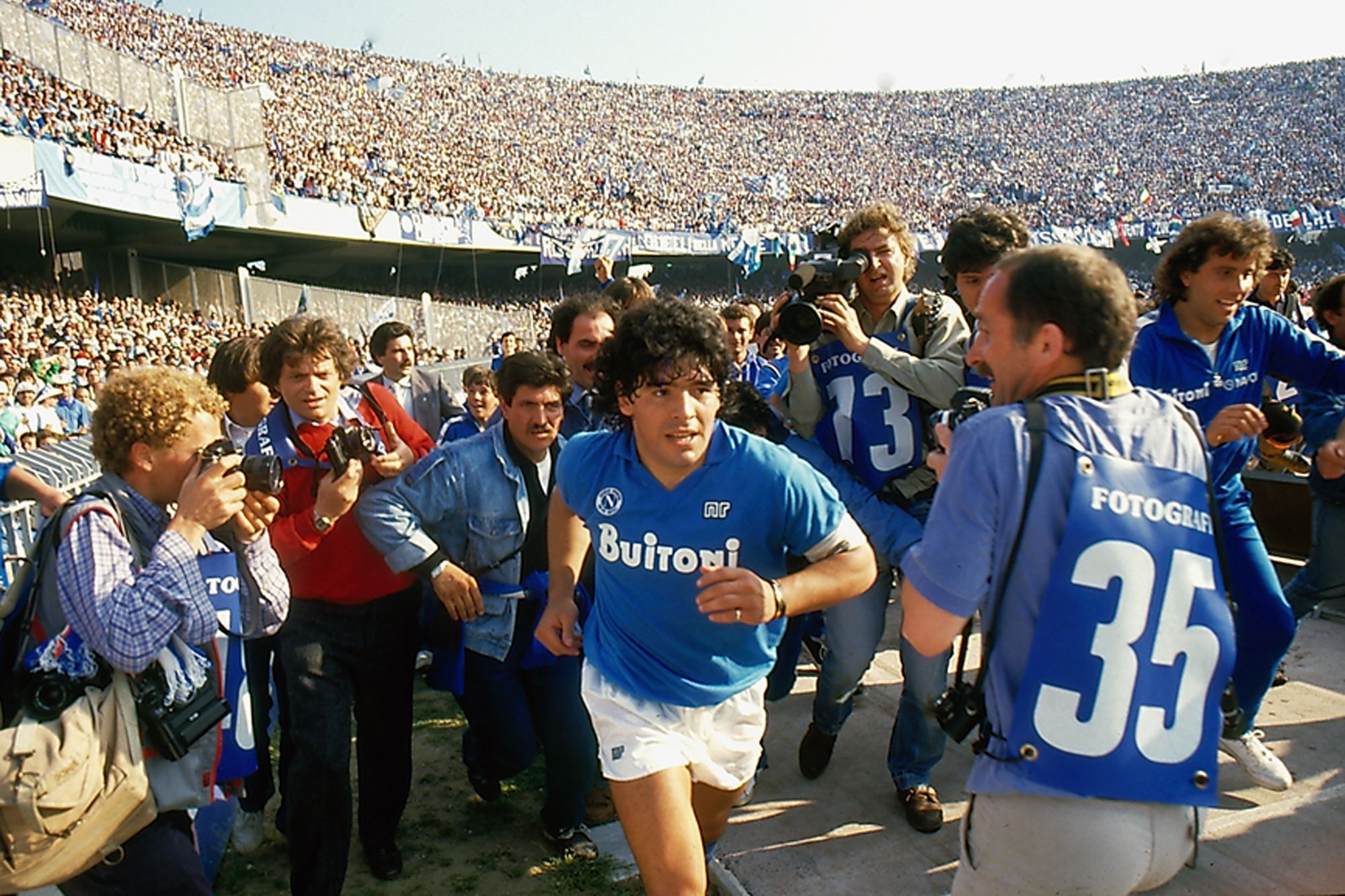Diego Maradona opens up in new Asif Kapadia documentary

And yet, during his seven years at Napoli, Maradona catapulted an unheralded team to become Italian league champions — twice — won the World Cup with Argentina and nearly came within a whisker of defending it.”The Golden Boy” collected golden boots like cereal box toys; scored arguably the sport’s most famous and infamous goals in the same game. To many Neapolitans and Argentines he was god. But you either die a hero or live long enough to see yourself become a villain. Such was the case as Maradona’s personal life went on to eclipse his exploits on the pitch. Now, after decades keeping the world at arm’s length, the Argentine has gone on the record to have his say on a narrative long-calcified in public memory. Debuting at the Cannes Film Festival, British Oscar-winning documentarian Asif Kapadia has made a punchy — and surprisingly tender — portrait of the star rising and falling like a celestial yo-yo, tracking the Argentine’s turbulent spell in Southern Italy.ConfessionalVisually, the film is composed entirely of archive footage, much of it culled from a 500-hour trove shot in the ’80s for an unmade documentary commissioned by Maradona’s one-time agent Jorge Cyterszpiler. However, it is Kapadia’s extensive access to the footballer himself that provides its revelations. Maradona, famously capricious, unspools himself in voiceover recorded by Kapadia at his home. The picture painted is one of a man grasping for equanimity, still wrestling to find peace with a life lived recklessly and unapologetically.READ: How Maradona redefined football in the space of five minutes”(Kapadia) achieved confessions … that I had never had after having followed him for 30 years as a journalist,” Maradona’s friend and biographer Daniel Arcucci told CNN Sport. And the footballer spilled all “in such a crude way, that I never expected from him.”Kapadia’s interviews find the filmmaker in new territory: both his previous subjects, Ayrton Senna and Amy Winehouse, were dead before film production began. “I was hoping to look back on his life a little bit and be able to present it to him while he’s still around,” the director said, “for him to reassess certain choices that he made.”Born 1960 in the Villa Fiorito area of Buenos Aires, Maradona was a “little black kid from the slum,” in the words of his former fitness coach Fernando Signorini.Football, says Maradona, “was my salvation,” lifting him and his family out of poverty as he rose through the ranks of Argentinos Junior and Boca Juniors, before leaving for a world record transfer fee to Barcelona in 1982. After an injury and illness-beset two seasons “there wasn’t another team in the world that would buy me,” Maradona says. Enter Napoli, the struggling relative in the Italian family. As one newsreader drolly puts it, “the poorest city in Italy buys the most expensive player in the world.”The CamorraNaples and Maradona had a natural affinity; the “Africans” of Italy is how the player coarsely describes the Neapolitans. Both were scrappy and fueled by adversity, both were passionate — perhaps too much so.”I was no saint,” Maradona says, reflecting on his infidelity. While his football dazzled at the 1986 World Cup in Mexico, his mistress Cristiana Sinagra was back in Italy, heavily pregnant with Diego Armando Maradona Sinagra. (For years the footballer refused to acknowledge paternity and did not meet his son until 2003). The documentary also covers occasions Maradona came into contact with the Camorra — the Neapolitan mafia — with Kapadia flashing up photographs of the footballer smiling alongside members of the crime syndicate. Representative for Maradona Stefano Ceci told CNN Sport via email that he could “categorically confirm that Mr. Diego Maradona has no involvement with the Neapolitan Camorra” and that the ex-player “has never been convicted by a court to support members of the Neapolitan Camorra (sic).”The photographs, he explained, were taken at a time when “Diego was the most unapproachable person in Naples” and that, as Napoli fans, “the most powerful Camorra family in Naples … on several occasions looked for a photo shoot with Maradona inviting (him) to various birthday parties of their family.”Parallel to Maradona’s on-field genius, alcohol and drugs flowed. “One hit and I felt like Superman,” Maradona recalls of his first experience with cocaine while at Barcelona.As a Napoli player at the height of his addiction he would party from Sunday to Wednesday, Maradona describing how he would return home and lock himself in the bathroom to hide from his infant daughters. ‘Lucifer lives in Naples’But the crown slipped from the prince of Naples when he broke Italian hearts, scoring for Argentina in the semifinal penalty shootout that knocked the hosts of out the 1990 World Cup. One Italian publication ran a story claiming “Lucifer lives in Naples.” A member of the Napoli Utlras, meanwhile, confesses in the film: “I am still upset with Diego.”The downfall was swift; the player was left isolated as the press turned on Maradona’s addiction woes.A 15-month football ban soon followed for a failed drugs test in 1991. His career wasn’t over — who can forget the midfielder’s stunning strike against Greece at the 1994 World Cup before falling foul to another failed drugs test? — but Maradona never recovered his form on the pitch.”He was used in a way,” Signorini told CNN, who makes a distinction between the mild-mannered “Diego” he knew and “Maradona,” a persona constructed as armor against a prying world.”It’s (like) you’re opening up a path in the jungle: the first one is the one who will have to confront all the dangers, then for others the path is already open,” he added. Subsequent footballers have learned from Maradona’s cautionary tale, Signorini implied, but for the Argentine “nobody could help him on this journey.” The wistful tone of many of the interviewees suggests they wish they could have. There’s more sadness to Kapadia’s film than anticipated, and Maradona is on hand to comment on what was going on behind his younger self’s often doleful expression. “By the end of (the interview sessions) I was asking quite tough questions,” said Kapadia. “He would try to divert and go off and give you something else entirely.” Eventually a begrudging respect formed, he added, with Maradona telling the director “‘at least you’ve got the nerve to ask those questions to my face, not like most of those journalists who do it when I’m not looking.'” At the time of writing Maradona had not seen the documentary, said Kapadia. Hopes that he would attend the gala screening at Cannes were dashed by a shoulder injury that kept him in Mexico where he is managing second-tier Dorados de Sinaloa.’);$vidEndSlate.removeClass(‘video__end-slate–inactive’).addClass(‘video__end-slate–active’);}};CNN.autoPlayVideoExist = (CNN.autoPlayVideoExist === true) ? true : false;var configObj = {thumb: ‘none’,video: ‘sports/2018/06/05/diego-maradona-goal-of-the-century-hand-of-god-argentina-england-world-cup-1986-spt-intl.cnn’,width: ‘100%’,height: ‘100%’,section: ‘international’,profile: ‘expansion’,network: ‘cnn’,markupId: ‘body-text_44’,theoplayer: {allowNativeFullscreen: true},adsection: ‘edition.cnn.com_worldsport_football_inpage’,frameWidth: ‘100%’,frameHeight: ‘100%’,posterImageOverride: {“mini”:{“width”:220,”type”:”jpg”,”uri”:”//cdn.cnn.com/cnnnext/dam/assets/180606092932-maradona-still-goal-century-tease-small-169.jpg”,”height”:124},”xsmall”:{“width”:307,”type”:”jpg”,”uri”:”//cdn.cnn.com/cnnnext/dam/assets/180606092932-maradona-still-goal-century-tease-medium-plus-169.jpg”,”height”:173},”small”:{“width”:460,”type”:”jpg”,”uri”:”//cdn.cnn.com/cnnnext/dam/assets/180606092932-maradona-still-goal-century-tease-large-169.jpg”,”height”:259},”medium”:{“width”:780,”type”:”jpg”,”uri”:”//cdn.cnn.com/cnnnext/dam/assets/180606092932-maradona-still-goal-century-tease-exlarge-169.jpg”,”height”:438},”large”:{“width”:1100,”type”:”jpg”,”uri”:”//cdn.cnn.com/cnnnext/dam/assets/180606092932-maradona-still-goal-century-tease-super-169.jpg”,”height”:619},”full16x9″:{“width”:1600,”type”:”jpg”,”uri”:”//cdn.cnn.com/cnnnext/dam/assets/180606092932-maradona-still-goal-century-tease-full-169.jpg”,”height”:900},”mini1x1″:{“width”:120,”type”:”jpg”,”uri”:”//cdn.cnn.com/cnnnext/dam/assets/180606092932-maradona-still-goal-century-tease-small-11.jpg”,”height”:120}}},autoStartVideo = false,isVideoReplayClicked = false,callbackObj,containerEl,currentVideoCollection = [],currentVideoCollectionId = ”,isLivePlayer = false,mediaMetadataCallbacks,mobilePinnedView = null,moveToNextTimeout,mutePlayerEnabled = false,nextVideoId = ”,nextVideoUrl = ”,turnOnFlashMessaging = false,videoPinner,videoEndSlateImpl;if (CNN.autoPlayVideoExist === false) {autoStartVideo = false;if (autoStartVideo === true) {if (turnOnFlashMessaging === true) {autoStartVideo = false;containerEl = jQuery(document.getElementById(configObj.markupId));CNN.VideoPlayer.showFlashSlate(containerEl);} else {CNN.autoPlayVideoExist = true;}}}configObj.autostart = CNN.Features.enableAutoplayBlock ? false : autoStartVideo;CNN.VideoPlayer.setPlayerProperties(configObj.markupId, autoStartVideo, isLivePlayer, isVideoReplayClicked, mutePlayerEnabled);CNN.VideoPlayer.setFirstVideoInCollection(currentVideoCollection, configObj.markupId);videoEndSlateImpl = new CNN.VideoEndSlate(‘body-text_44’);function findNextVideo(currentVideoId) {var i,vidObj;if (currentVideoId && jQuery.isArray(currentVideoCollection) && currentVideoCollection.length > 0) {for (i = 0; i 0) {videoEndSlateImpl.showEndSlateForContainer();if (mobilePinnedView) {mobilePinnedView.disable();}}}}callbackObj = {onPlayerReady: function (containerId) {var playerInstance,containerClassId = ‘#’ + containerId;CNN.VideoPlayer.handleInitialExpandableVideoState(containerId);CNN.VideoPlayer.handleAdOnCVPVisibilityChange(containerId, CNN.pageVis.isDocumentVisible());if (CNN.Features.enableMobileWebFloatingPlayer &&Modernizr &&(Modernizr.phone || Modernizr.mobile || Modernizr.tablet) &&CNN.VideoPlayer.getLibraryName(containerId) === ‘fave’ &&jQuery(containerClassId).parents(‘.js-pg-rail-tall__head’).length > 0 &&CNN.contentModel.pageType === ‘article’) {playerInstance = FAVE.player.getInstance(containerId);mobilePinnedView = new CNN.MobilePinnedView({element: jQuery(containerClassId),enabled: false,transition: CNN.MobileWebFloatingPlayer.transition,onPin: function () {playerInstance.hideUI();},onUnpin: function () {playerInstance.showUI();},onPlayerClick: function () {if (mobilePinnedView) {playerInstance.enterFullscreen();playerInstance.showUI();}},onDismiss: function() {CNN.Videx.mobile.pinnedPlayer.disable();playerInstance.pause();}});/* Storing pinned view on CNN.Videx.mobile.pinnedPlayer So that all players can see the single pinned player */CNN.Videx = CNN.Videx || {};CNN.Videx.mobile = CNN.Videx.mobile || {};CNN.Videx.mobile.pinnedPlayer = mobilePinnedView;}if (Modernizr && !Modernizr.phone && !Modernizr.mobile && !Modernizr.tablet) {if (jQuery(containerClassId).parents(‘.js-pg-rail-tall__head’).length) {videoPinner = new CNN.VideoPinner(containerClassId);videoPinner.init();} else {CNN.VideoPlayer.hideThumbnail(containerId);}}},onContentEntryLoad: function(containerId, playerId, contentid, isQueue) {CNN.VideoPlayer.showSpinner(containerId);},onContentPause: function (containerId, playerId, videoId, paused) {if (mobilePinnedView) {CNN.VideoPlayer.handleMobilePinnedPlayerStates(containerId, paused);}},onContentMetadata: function (containerId, playerId, metadata, contentId, duration, width, height) {var endSlateLen = jQuery(document.getElementById(containerId)).parent().find(‘.js-video__end-slate’).eq(0).length;CNN.VideoSourceUtils.updateSource(containerId, metadata);if (endSlateLen > 0) {videoEndSlateImpl.fetchAndShowRecommendedVideos(metadata);}},onAdPlay: function (containerId, cvpId, token, mode, id, duration, blockId, adType) {/* Dismissing the pinnedPlayer if another video players plays an Ad */CNN.VideoPlayer.dismissMobilePinnedPlayer(containerId);clearTimeout(moveToNextTimeout);CNN.VideoPlayer.hideSpinner(containerId);if (Modernizr && !Modernizr.phone && !Modernizr.mobile && !Modernizr.tablet) {if (typeof videoPinner !== ‘undefined’ && videoPinner !== null) {videoPinner.setIsPlaying(true);videoPinner.animateDown();}}},onAdPause: function (containerId, playerId, token, mode, id, duration, blockId, adType, instance, isAdPause) {if (mobilePinnedView) {CNN.VideoPlayer.handleMobilePinnedPlayerStates(containerId, isAdPause);}},onTrackingFullscreen: function (containerId, PlayerId, dataObj) {CNN.VideoPlayer.handleFullscreenChange(containerId, dataObj);if (mobilePinnedView &&typeof dataObj === ‘object’ &&FAVE.Utils.os === ‘iOS’ && !dataObj.fullscreen) {jQuery(document).scrollTop(mobilePinnedView.getScrollPosition());playerInstance.hideUI();}},onContentPlay: function (containerId, cvpId, event) {var playerInstance,prevVideoId;if (CNN.companion && typeof CNN.companion.updateCompanionLayout === ‘function’) {CNN.companion.updateCompanionLayout(‘restoreEpicAds’);}clearTimeout(moveToNextTimeout);CNN.VideoPlayer.hideSpinner(containerId);if (Modernizr && !Modernizr.phone && !Modernizr.mobile && !Modernizr.tablet) {if (typeof videoPinner !== ‘undefined’ && videoPinner !== null) {videoPinner.setIsPlaying(true);videoPinner.animateDown();}}},onContentReplayRequest: function (containerId, cvpId, contentId) {if (Modernizr && !Modernizr.phone && !Modernizr.mobile && !Modernizr.tablet) {if (typeof videoPinner !== ‘undefined’ && videoPinner !== null) {videoPinner.setIsPlaying(true);var $endSlate = jQuery(document.getElementById(containerId)).parent().find(‘.js-video__end-slate’).eq(0);if ($endSlate.length > 0) {$endSlate.removeClass(‘video__end-slate–active’).addClass(‘video__end-slate–inactive’);}}}},onContentBegin: function (containerId, cvpId, contentId) {if (mobilePinnedView) {mobilePinnedView.enable();}/* Dismissing the pinnedPlayer if another video players plays a video. */CNN.VideoPlayer.dismissMobilePinnedPlayer(containerId);CNN.VideoPlayer.mutePlayer(containerId);if (CNN.companion && typeof CNN.companion.updateCompanionLayout === ‘function’) {CNN.companion.updateCompanionLayout(‘removeEpicAds’);}CNN.VideoPlayer.hideSpinner(containerId);clearTimeout(moveToNextTimeout);CNN.VideoSourceUtils.clearSource(containerId);jQuery(document).triggerVideoContentStarted();},onContentComplete: function (containerId, cvpId, contentId) {if (CNN.companion && typeof CNN.companion.updateCompanionLayout === ‘function’) {CNN.companion.updateCompanionLayout(‘restoreFreewheel’);}navigateToNextVideo(contentId, containerId);},onContentEnd: function (containerId, cvpId, contentId) {if (Modernizr && !Modernizr.phone && !Modernizr.mobile && !Modernizr.tablet) {if (typeof videoPinner !== ‘undefined’ && videoPinner !== null) {videoPinner.setIsPlaying(false);}}},onCVPVisibilityChange: function (containerId, cvpId, visible) {CNN.VideoPlayer.handleAdOnCVPVisibilityChange(containerId, visible);}};if (typeof configObj.context !== ‘string’ || configObj.context.length 0) {configObj.adsection = window.ssid;}CNN.autoPlayVideoExist = (CNN.autoPlayVideoExist === true) ? true : false;CNN.VideoPlayer.getLibrary(configObj, callbackObj, isLivePlayer);});CNN.INJECTOR.scriptComplete(‘videodemanddust’);Shoulder injuries aside, Kapadia’s film argues that at the age of 58, perhaps some of Maradona’s internal wounds have begun to heal. The film’s postscript suggests, by the footballer’s standards, a journey has been taken in recent years. So is Maradona now at peace with himself? “I hope so,” said the director.


